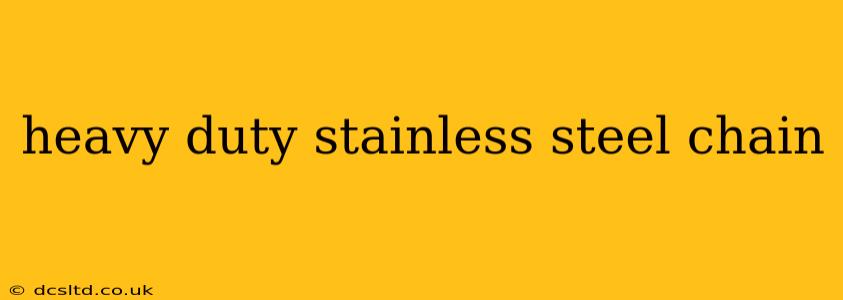Heavy-duty stainless steel chain offers unparalleled strength, corrosion resistance, and longevity, making it ideal for a wide range of demanding applications. From industrial settings to marine environments, its robust construction and reliable performance make it a preferred choice for securing heavy loads, anchoring equipment, and creating durable linkages. This guide delves into the specifics of heavy-duty stainless steel chain, covering its properties, applications, and selection considerations.
What Makes Heavy Duty Stainless Steel Chain So Durable?
The exceptional durability of heavy-duty stainless steel chain stems from the combination of its material properties and manufacturing processes. Stainless steel itself is an alloy of iron, chromium, and other elements, providing inherent resistance to rust and corrosion. The high chromium content creates a passive oxide layer on the surface, preventing further oxidation and maintaining the chain's structural integrity even in harsh environments. Furthermore, the manufacturing process, which involves carefully controlled forging or welding techniques, ensures consistent strength and minimizes flaws that could compromise the chain's performance.
What are the Different Grades of Stainless Steel Chain?
Several grades of stainless steel are used in the production of heavy-duty chains, each possessing unique characteristics and suitability for specific applications. The most common grades include:
- 304 Stainless Steel: This grade offers good corrosion resistance and is suitable for many general-purpose applications.
- 316 Stainless Steel: Offering superior corrosion resistance compared to 304, 316 stainless steel is ideal for marine environments and applications exposed to chlorides.
- 316L Stainless Steel: This low-carbon variant of 316 stainless steel exhibits even greater resistance to pitting and crevice corrosion, making it a preferred choice for highly corrosive environments.
The grade of stainless steel used will significantly influence the chain's overall performance and lifespan. Selecting the appropriate grade is crucial for ensuring the chain meets the demands of the specific application.
What are the Common Applications of Heavy Duty Stainless Steel Chain?
The versatility of heavy-duty stainless steel chain makes it suitable for a wide variety of applications across diverse industries:
- Lifting and Hoisting: Securely lifting and transporting heavy loads in industrial settings.
- Anchoring and Securing: Providing reliable anchoring points for equipment and structures.
- Marine Applications: Essential for mooring boats, securing cargo, and other maritime uses.
- Construction and Engineering: Used in various construction applications, from structural support to load-bearing systems.
- Agricultural Applications: Employing heavy-duty chains in agricultural machinery and equipment.
How to Choose the Right Heavy Duty Stainless Steel Chain?
Selecting the appropriate heavy-duty stainless steel chain requires careful consideration of several factors:
- Working Load Limit (WLL): The maximum load the chain can safely support under normal operating conditions. This is a critical factor to ensure safe and reliable operation.
- Chain Grade: As mentioned previously, selecting the correct stainless steel grade is essential based on the environmental conditions and intended use.
- Chain Size and Length: The chain's diameter and overall length must be sufficient to handle the anticipated load and application requirements.
- Chain Type: Different chain types, such as short-link, long-link, or stud-link chains, are designed for specific applications and load capacities. Selecting the right type ensures optimal performance and safety.
Ignoring these factors can lead to chain failure, potentially resulting in damage, injury, or even fatalities.
What is the difference between Grade 304 and 316 Stainless Steel Chains?
The primary difference lies in their corrosion resistance. Grade 316 stainless steel contains molybdenum, which significantly enhances its resistance to pitting and crevice corrosion, particularly in chloride-rich environments like saltwater. Grade 304 offers good corrosion resistance in many applications, but it's less resistant to chlorides than 316. Therefore, Grade 316 is preferred for marine applications and other environments with high chloride exposure.
How do I maintain a heavy duty stainless steel chain?
Proper maintenance is crucial to prolonging the lifespan of your heavy-duty stainless steel chain. Regular inspections for signs of wear and tear, such as stretching, kinking, or corrosion, are essential. Cleaning the chain periodically to remove dirt, debris, and corrosive substances can also help maintain its integrity. Prompt replacement of any damaged or worn components is vital to prevent potential failures.
Where can I buy heavy duty stainless steel chain?
Heavy-duty stainless steel chain is readily available from industrial supply companies, marine equipment suppliers, and online retailers specializing in hardware and fasteners. When purchasing, always ensure the chain conforms to relevant safety standards and that you choose a reputable supplier.
This comprehensive guide provides valuable insights into the world of heavy-duty stainless steel chain. Remember that safety should always be the top priority when working with heavy loads and equipment. Choosing the correct chain and adhering to safe practices are crucial to ensuring both the success of your project and the safety of those involved.
